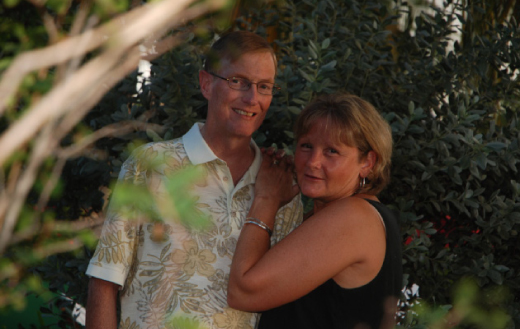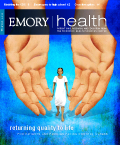A heart for health
In most respects, 51-year-old David Bridges had a normal childhood. Except that he wasn’t expected to have a childhood in the first place.
Bridges (pictured above with his wife) was born with a rare and complex heart defect called tricuspid atresia, characterized by a nonfunctioning heart valve that makes it impossible for a heart to pump enough blood and oxygen through the bloodstream and into the lungs. The result? A bluish pallor and difficulty for patients to catch their breaths.
Before Bridges’s generation, the outlook was poor for those for this condition and other congenital heart defects. “Most people with complex heart defects died in childhood,“ says Emory cardiologist Wendy Book. And Bridges’s childhood physicians expected the same for him. “The doctors didn’t think I was going to live that long,” he says.
But defying the odds, Bridges became a pioneering patient with the help of a heart shunt that carried blood between his heart and lungs. The shunt enabled him to play an occasional game of football or baseball—at least until he was out of breath. However, as he got older, moving around got harder and harder on Bridges and his heart. At 18, he was a freshman in college and running out of breath when he simply tried to climb a few stairs.
Soon after, Bridges became one of the first people to undergo a Fontan procedure, a then-experimental surgery to create a new pathway between his veins and pulmonary arteries. “They didn’t know what my life expectancy would be afterward. They didn’t know the consequences,” Bridges says.
Although the Fontan procedure is widely used today, doctors like Wendy Book are still figuring out its long-term impact. “Those who had the Fontan operation typically begin to have problems 20 to 25 years after,” she says. “Those problems are related to the high pressures that develop because the veins are connected to the lungs without a pump.” Bridges and others have dealt with such symptoms as swelling in the liver and bowels, varicose veins, liver scarring, extreme protein loss, immune system deficiencies, and heart rhythm problems.
A decade ago Bridges came for treatment of such problems to Book’s office at Emory’s Adult Congenital Heart (EACH) Center, the largest multidisciplinary program of its kind in the Southeast. The EACH Center works in collaboration with the Sibley Heart Center for children, pairing pediatric and adult cardiologists to provide the best care.
Multidisciplinary teams include cardiologists, surgeons, hepatologists, hematologists, anesthesiologists, nurse practitioners, social workers, and others. More than 2,000 congenital heart patients come there annually for treatments and checkups. “I’m challenged every minute of every day trying to come up with solutions,” says Book.
But Bridges says that Book and her staff have met each of his medical challenges with expertise and aplomb. As a result of their collaboration, he’s healthier now than he was a few years ago. And he trusts his cardiologist enough to try any other new procedures or medications that she recommends. “I’ll be your lab rat,” he has volunteered.
The busy doctor, however, may have to work around her patient’s schedule. These days, Bridges travels often with his wife, living his life as fully as possible. “The fact that I’ve beaten all of the odds they’ve given me over the years—it’s sort of a neat feeling,” he says. But it’s not the only thing on his mind. “We’re going to St. Lucia to have some sun and fun zip-lining through the jungle,” he says. “I have a lot of living to do.” —Dana Goldman



